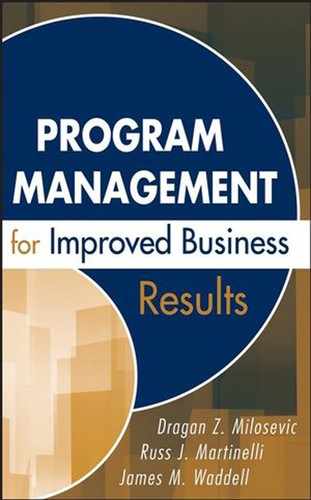While Part I dealt with the strategic purpose of program management, Part II delves into details of how to manage a single program from its inception to end of life. It consists of four chapters—The Program Team, Program Definition and Planning, Program Execution, and Program Processes.
Chapter 5 is about the program team. It emphasizes two critical factors that matter when structuring a program. First, the program team structure must support the highly integrated nature of a program. Second, the program team structure must enable the fundamental elements for team success—from coordination of its activities and interdependent deliverables to collective problem solving. A fundamental lack of understanding in the difference between a program team structure and a project team structure often stands in the way of successfully structuring a program. This is mainly because managers incorrectly use their experience in establishing project team structures for programs; there is also a wealth of available information on establishing project structures, which contributes to this problem. The most effective program structure we've experienced is the core team structure. With the PCT structure in place, an organization becomes well-positioned to achieve improved business results, both strategic and tactical in nature. Strategic benefits relate to establishing a framework to link business strategy and execution output. Tactical benefits include providing the foundation necessary to either break down product and process complexity or to fully identify and evaluate risk to the product, service, or infrastructure under development, as well as risk to the business.
Chapter 6 focuses on the define and plan phases of the PLC. The program definition process involves the steps necessary to integrate business strategy, customer and end-user research, and technology research into a viable product, service, or infrastructure concept. The viability of the concept is then validated through the creation and analysis of a comprehensive program business case. The program planning process spells out the steps necessary to channel the product, service, or infrastructure concept into a cross-project, multi-discipline implementation plan. When executed, the program implementation plan will become the means to achieve the business objectives intended. Lastly, this chapter provides a set of important behaviors that highly effective program managers exhibite during the program definition and planning phases.
The purpose of Chapter 7, Program Execution, is to focus on execution of the implementation plan to create the whole product, service, or infrastructure and prepare for the launch of the program output into the market or end-user's environment. It looks at the implement, launch, and sustain phases of the PLC. While the second phase, launch, has received some attention in literature, the sustain phase and process are seldom covered. We describe the steps necessary to keep the program business running as effectively and efficiently as possible after a product, service, or infrastructure capability is launched. Additionally, the steps to fully support the customers and end users ensure that the business objectives of the program are attained and that the program remains viable from a business perspective. The close out of the program, when it reaches end of life, is also covered in this chapter.
Chapter 8 describes the primary program processes that a program manager can utilize to make the operational aspects of a program—the PLC, schedule management, financial management, risk management, change management, and stakeholder management—more efficient, predictable, and repeatable. The PLC is a framework that can be used to synchronize the work, deliverables, and decisions on a program. The schedule management process is used to manage the horizontal collaboration between the project teams over time. The financial management process is used to manage the financial aspects of a program, such as cost estimation and control, financial feasibility assessments, and cash flow management. The risk management process can be used to identify and proactively deal with the various risk factors surrounding the program before they become problems that have to be reactively managed. The change management process is a program manager's greatest weapon to combat program scope creep. Finally, stakeholder management is a process with which a program manager can manage the communication, political, and conflict resolution aspects of a program.
